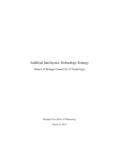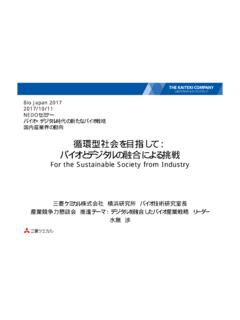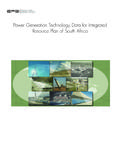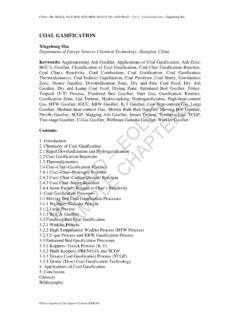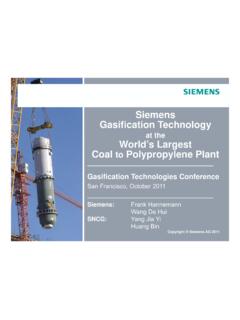Transcription of Studies for Project Development and Organization Program ...
1 Feasibility Studies with the Aim of Developing a Bilateral Offset Credit MechanismFY2011 Studies for Project Development and OrganizationStudies for Project Development and OrganizationProgram Organization research of Ultra Super Critical (USC) coal-fired thermal power plant construction Project in the Republic of IndiaNew Energy and Industrial Technology Development Organization (NEDO)Mizuho Information & Research Institute, Corporate Bank, 2I. IntroductionBackground : This report summarizes the results of the feasibility study of introducing an ultra super critical (USC) coal-fired thermal power plant rated at 2,000 MW (two 1,000 MW generators)to the Republic of India. The purposes are to support the design of a bilateral offset credit mechanism (BOCM) to be introduced by the Japanese government and to provide information to peoples connected with overseas governments and a variety of stakeholders who are interested in the outline of this research report : Chapter II: Survey of the Indian power Market and Measures against Climate Change organizes basic information necessary to the promotion of this Project .
2 Chapter III: Basic Design of power Plant describes how we designed an USC coal fired thermal power plant expected by this Project and what we investigated to develop system specifications necessary to the Project and to draw up a Project implementation plan. Chapter IV: Review of the MRV Method describes the MRV method employed in this Project and summarizes issues in the estimation of green gas reduction and its methods. Chapter V: Consideration toward the Design of a Bilateral Offset Credit Mechanism shows issues in the system design identified through this investigation and organizes arguing 3II. Survey of the Indian power Market and Measures against Climate state and future prospect of power generation plans Currently, most of electric power companies employ subcritical coal-fired thermal power plants , and only small part of them introduces super critical (SC)technology. Currently, only one companyplans to employ the ultra super critical (USC) cycle shown in this investigation, but does not announce when it starts.
3 Many companies are interested inUSC technologybut recognize that it is less advantageous than subcritical and SC technologies from the viewpoints of the initial cost. plans Most of the electric power companies assume a basic finance model whose debt/equity = 70 80/30 20. Some have dealings with overseas banks but many companies raise funds from domestic financial institutions. The opinion Importance should be given to (1) Reduction in initial cost, (2) Low-interest loans, and (3) Long repayment period dominates the state power market. of introducing Japanese technology and of joint ventures The appliance procurement market is dominated by BHEL and L&T (domestic companies), which are followed by Chinesecompanies. India gives importance to the cost reduction of poweras a measure for demand far beyond supply rather than a rise in energy efficiency. Many Indian companies give priority to initial costs rather than life-cycle expenses, so they require foreign companies to work out a scheme for reducing the initial page on CDM It is well known that India has several coal fired thermal power generation projects that aim to be listed in the CDM Registry.
4 They have common opinionsshown below;9 The registration process takes too long is difficult to prove additionality. These are hurdles they shall jump over. In addition, they encounterthe following problems:9 Communication with CDM Executive Board is not specified baseline is too are on BOCM A certain company says that it has no idea as far as no BOCM agreement is made between Japanese and Indian governments, while many companies have a good impression on BOCM because it is more flexible than CDM. In addition, companies which have already been working on CDM deepen their understanding of BOCM through a description from Japan and put many good questions and opinions about system design, which are shown do you specify credit prices?(It should be higher than CER.)9 Can Indian companies receive income given by selling the credit at an early stage?9 The credit issuance period should be registration process should be shorter.
5 Some companies understand that ACM0013 is put on hold and credits issued from India Project registered after 2012 cannot be used in the third phase of EU ETS. That is to say, the Indian electric power companies know that BOCM promoted by Japan is advantageous to them. Accordingly, in order for the Japanese side to design BOCM in detail and to make an agreement with the Indian side, it is important to prepare a campaign for showing advantages to the Indian companies, such as giving a continuous and polite description, buying the credit shown above at a high price, and providing profits in Survey of the Indian power Market and Measures against Climate Change(continued)page 5 III. Basic Design of power Plant Comparing Thermal power Generation Cycles Super critical (SC) cycle: Thermal power generator having a steam cycle rated at a main steam pressure of not less than 22 MPa, a main steam temperature of 566 degC, and a reheat steam temperature of up to 593degC.
6 Ultra super critical (USC) cycle: Thermal power generator having a steam cycle rated at a main steam pressure of not less than MPa, a main steam temperature of not less than 593 degC, and a reheat steam temperature of not less than 593 degC. Advanced ultra super critical (A USC) cycle: Thermal power generator having a steam cycle rated at a main steam pressure of 35 MPa, a main steam temperature of 700 degC, and a reheat steam temperature of 720 degC. Integrated coal gasification combined cycle (IGCC): Thermal power generator consisting of a coal gasification furnace and gasturbine. The subcritical cycle applies to the steam cycle because exhaust heat from the gas turbine is used as a heat cycleUSC cycleA-USC cycleIGCCS team pressure> 22 MPa> Steam temperature< 566 C/593 C> 593 C/593 C700 C/720 C/720 C Net thermal efficiency (HHV)40%42%46%46%CO2emissions per unit energy815g-CO2/kWh776-CO2/kWh709-CO2/kWh 709-CO2/kWhMaturity of technologyCommercial stageCommercial stageDeveloping stageDemonstrating stageConstruction cost< JPY270k/kWJPY272k/kW JPY290k/kW (target) power generation costJPY as USC (target)Same as USC (target)Results of comparing the various cycles page 6 III.
7 Basic Design of power Plant(continued)Note: The CO2 emission factors of coal and oil are g CO2/1,000 kcal and g CO2/1,000 kcal respectively, and the HHV efficiency of oil fired thermal power generation is 36 %.Source: We have created this table according to various documents and excerpted the construction and power generation costs from No. 11 IEEJ Seminar delivered by Agency for Natural Resources and Energy, METI in February of the net thermal efficiencies under Japanese Circumstances Comparison of CO2 emissions on a cycle basis under Japanese Circumstances The left side figure shows the net thermal efficiency of each technology under Japanese circumstances (low cooling water temperature and high coal property, etc.). Since the 1980s, the net thermal efficiency has increased year by year. Comparing the estimated CO2 emissions per unit energy indicates that the A-USC cycle and IGCC have the almost same CO2 emission as oil-fired thermal power generation though they use coal as a fuel (right hand figure).
8 Page 7IV. Review of MRV methodologies Identification of baseline monitoring methodologies Considering economic attraction and technical issues, the baseline scenarios at the moment is introduction of the subcritical coal fired power generation. However, since it is assumed that the period of the power generation Project is long and that technology introduction is likely to be accelerated in the years ahead, a review of the baseline scenarios may be required in the future. Also, a review of the necessity for a system for regularly reviewing the baseline with the host country s governments may be required. Accordingly, this survey also evaluates possible reduction resulting from the baseline scenario of the supercritical coal fired generation for future review. Proposed baselineDescription1) subcritical coal fired generation Subcritical technologies will be introduced as power plants capable of generating the output equal to envisioned scale.
9 This option not only complies with all relevant laws and regulations, but also gives the highest cost competitiveness with matured existing technologies and years of experience in ) SC coal fired power plant Supercritical (SC) coal fired power plant will be introduced as power plants capable of generating the output equal to the envisioned scale. At last, the introduction of SC coal fired power plants has begun. It has higher initial construction cost than the subcritical plant and limited or no experience in operation using introduced technique. Due to such a risk, the SC may result in a greater barrier to the introduction than the ) USC coal fired power plant Ultra super critical (USC) coal fired power plant will be introduced as power plants capable of generating the output equal to the envisioned scale. Very limited experience in USC coal fired power plants . For this, they result in greater barrier to the introduction than the subcritical of baseline scenarios (excerption) page 8V.
10 Discussion about bilateral offset credit mechanism design Points in the design of the BOCM conceivable through this survey are described framework Treatment of reduction activities including other country s technologies and products How the technologies are deployed by the multinational consortium including Japan should be discussed. Treatment of reduction activities by other country s technologies and products How the following options are treated would become the major issues to be examined in the future. when projects that include no Japanese technologies are applied as bilateral credits, when products using other country s technologies are exported as Japanese products, when Japanese companies are involved only through of credits Allotment of credits by partner country and Japanese governments Almost no discussion is made as to how credits issued by the partner country government and Japanese government are allotted.
